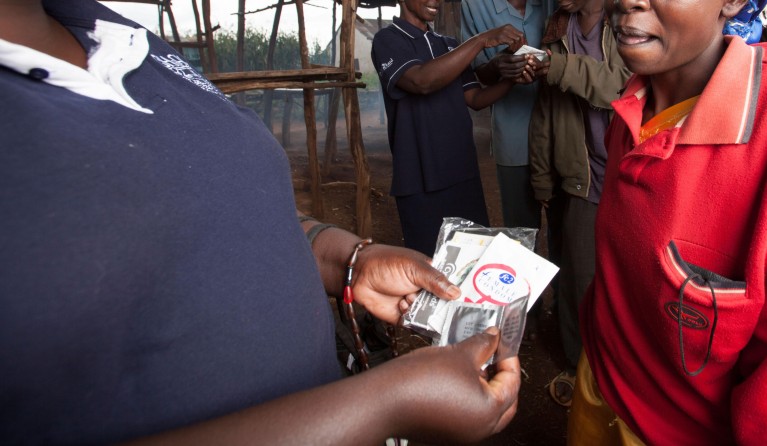
A community health worker explains various forms of contraception during an outreach session in a Kenyan market.Credit: Tom Gilks / Alamy Stock Photo
A lack of access to contraception is contributing to a rising number of unplanned births, unsafe abortions, miscarriages and stillbirths in several countries across Africa.
A study in Population and Research Review projects that if contraceptive coverage in low to middle income countries (LMICs) is unchanged, some 218 million women may not have access modern contraceptives, leading to 97 million unintended pregnancies by 2030. Elizabeth Sully, senior research scientist and colleagues from Guttmacher Institute, a research and policy organization, says that the United Nation’s Sustainable Development Goals (SDGs) 3, 4 and 5 targeting health, education and gender equality are dependent on improvements in “sexual and reproductive health and rights”.
Africa’s governments must take collective action to address the continent’s maternal death numbers, which account for about half the global toll, says Isaac Adewole, a professor of gynecology and obstetrics from Nigeria. “We should stop treating women as if they are disposable.”
The SDGs call for a reduction of the global maternal mortality ratio (MMR) to fewer than 70 maternal deaths per 100,000 live births by 2030, with no individual country exceeding 140 deaths. A recent study published in Nature Medicine suggests this goal is a long way from being achieved, with a projection of 167 maternal deaths per 100,000 live births in 2030. As many as 58 countries are expected to be above the 140 target. The researchers say that maternal mortality is projected to remain high in Africa because of rapid population growth, highlighting the need to consider all the reasons for maternal mortality when evaluating progress.
“Policy interventions or socioeconomic trends that impact fertility may yield little change in the MMR, while having a substantial impact on other indicators such as the number of maternal deaths and the lifetime risk of maternal death,” the study says.
A study in Kenya published in Plos One found that women and girls of reproductive age experience barriers to access contraceptives and related health services including proximity to health facilities, cost of services, negative cultural influences, and lack of privacy and confidentiality.
Adewole reiterates the need for efforts to ensure youths avoid early marriages and remain in school, while Mphu Ramatlapeng, consultant for Shaping Equitable Market Access for Reproductive Health (SEMA) has called for the breaking of obstacles to access of contraceptives.
“If we do not meet sexual reproductive health targets, then the majority of the SDGs may not be met as women and girls are involved in initiatives to realise all the SDGs,” she says.
